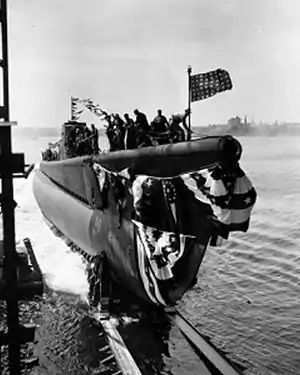 | |
| History | |
|---|---|
| Builder | Electric Boat Company, Groton, Connecticut[1] |
| Laid down | September 21, 1942[1] |
| Launched | May 9, 1943[1] |
| Sponsored by | Mrs. R. W. Christie |
| Commissioned | August 6, 1943[1] |
| Fate | Sunk by Japanese submarine I-176 south of Truk Lagoon, November 16, 1943[2] |
| General characteristics | |
| Class and type | Gato-class diesel-electric submarine[2] |
| Displacement | |
| Length | 311 ft 9 in (95.02 m)[2] |
| Beam | 27 ft 3 in (8.31 m)[2] |
| Draft | 17 ft (5.2 m) maximum[2] |
| Propulsion |
|
| Speed | |
| Range | 11,000 nmi (20,000 km) surfaced at 10 kn (19 km/h)[6] |
| Endurance |
|
| Test depth | 300 ft (90 m)[6] |
| Complement | 6 officers, 54 men[6] |
| Armament |
|
USS Corvina (SS-226), a Gato-class submarine, was the only ship of the United States Navy to be named for the corvina.[7]
Construction and commissioning
Corvina′s keel was laid down by the Electric Boat Company of Groton, Connecticut, on September 21, 1942. She was launched on May 9, 1943, sponsored by Mrs. LaRene P. Christie, wife of Rear Admiral Ralph. W. Christie, commander of submarine operations in Fremantle, Australia, and commissioned on August 6, 1943.
Service record
Clearing New London, Connecticut, on September 18, 1943, Corvina arrived at Pearl Harbor on October 14. She put out from Pearl Harbor on her maiden war patrol November 4, topped up her fuel tanks at Johnston Island two days later, and was never heard from again.
Her assignment had been a dangerous one: to patrol as closely as possible to the heavily guarded stronghold of Truk and to intercept any Japanese sortie endangering the forthcoming American invasion of the Gilbert Islands. Japanese records report that Japanese submarine I-176 launched three torpedoes at an enemy submarine south of Truk on November 16, claiming two hits which resulted in the explosion of the target.[8] Her loss with her crew of 82 was announced March 14, 1944, making Corvina the only American submarine to have been sunk by a Japanese submarine in the entire war.[9]
In popular culture
The 1951 John Wayne film Operation Pacific makes reference to the loss of Corvina. In the film, the fictitious Gato-class submarine USS Thunderfish makes an impromptu rendezvous with Corvina after Corvina reported problems with her Number 4 diesel engine. The submarimes exchange engine parts and the commanding officers also exchange films, Lieutenant Commander Duke E. Gifford (played by Wayne) offering George Washington Slept Here and Corvina′s captain offering "a submarine picture," later revealed to be the 1943 film Destination Tokyo. Later, while the crew of Thunderfish is watching Destination Tokyo, Gifford tries to figure out the source of torpedo explosions reported by Thunderfish′s sonar operator. The following day, Thunderfish comes across wreckage, and discovers the case containing George Washington Slept Here, revealing that Corvina had been sunk. Thunderfish′s radar then reports a single contact, and the submarine submerges. Gifford discovers "one I-type Jap submarine" while looking through the periscope. Thunderfish then engages, torpedoes, and sinks the Japanese submarine, avenging the loss of Corvina.
See also
References
- 1 2 3 4 Friedman, Norman (1995). U.S. Submarines Through 1945: An Illustrated Design History. Annapolis, Maryland: United States Naval Institute. pp. 285–304. ISBN 1-55750-263-3.
- 1 2 3 4 5 6 7 Bauer, K. Jack; Roberts, Stephen S. (1991). Register of Ships of the U.S. Navy, 1775-1990: Major Combatants. Westport, Connecticut: Greenwood Press. pp. 271–273. ISBN 0-313-26202-0.
- 1 2 3 4 5 Bauer, K. Jack; Roberts, Stephen S. (1991). Register of Ships of the U.S. Navy, 1775–1990: Major Combatants. Westport, Connecticut: Greenwood Press. pp. 270–280. ISBN 978-0-313-26202-9. OCLC 24010356.
- ↑ U.S. Submarines Through 1945 p. 261
- 1 2 3 U.S. Submarines Through 1945 pp. 305–311
- 1 2 3 4 5 6 U.S. Submarines Through 1945 pp. 305-311
- ↑ "USS Corvina". Wrecksite. Retrieved 23 March 2018.
- ↑ "Corvina (SS 226)". Navy Department Library. Retrieved January 21, 2014.
- ↑ Boyd, Carl; Yoshida, Akihiko (1995). The Japanese Submarine Force and World War II. Naval Institute Press. p. 236. ISBN 9781557500151. Retrieved January 21, 2014.
This article incorporates text from the public domain Dictionary of American Naval Fighting Ships. The entry can be found here.